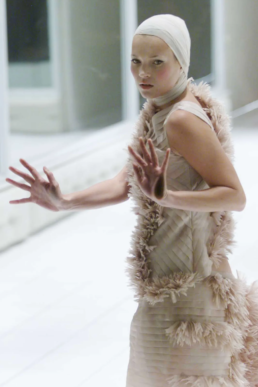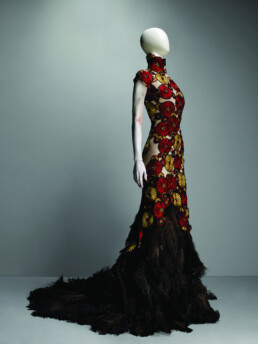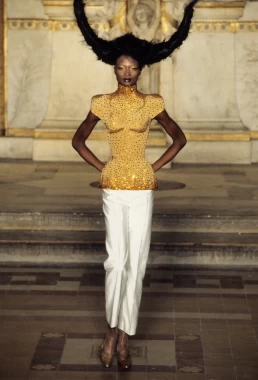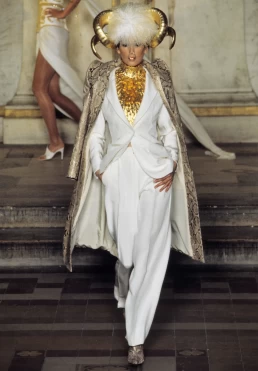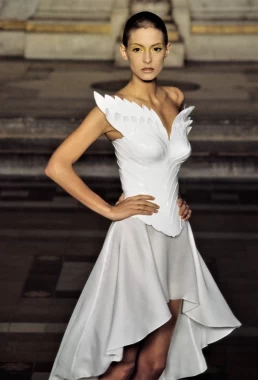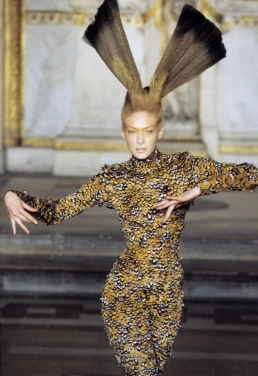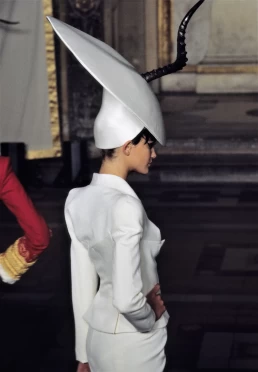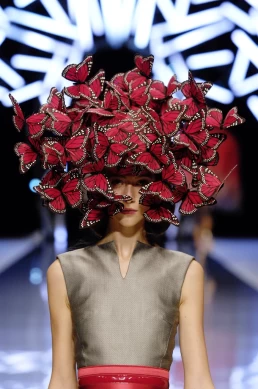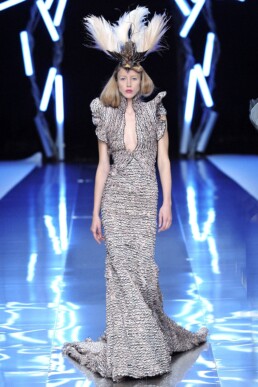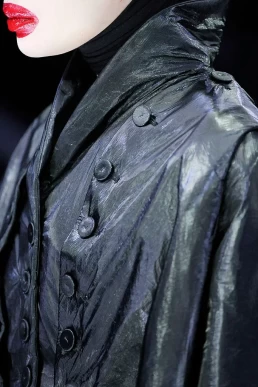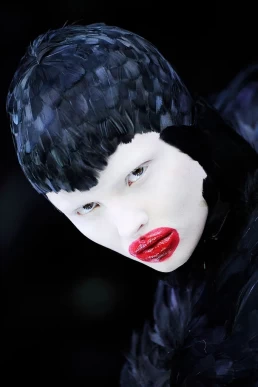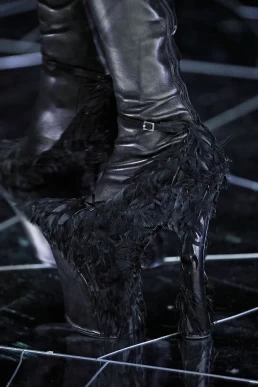ALEXANDER McQUEEN
Woven in Shadows (Pt 3) Companion Gallery

What happens to Alexander McQueen when he achieves his life’s dream? Is he able to continue creating inspired collections in spite of the intense pressures of global fame? What are the personal meanings behind his most iconic collections? And what leads to his tragic end?
We explore all of these questions and much more on this finale to the McQueen series.
Below you’ll find the companion gallery for this episode. It features the imagery and video footage of some of McQueen’s most iconic collections from 1997 – 2010.
VOSS, S/S 2001
VOSS is one of Alexander McQueen’s greatest creative achievements. Set in an imagined mental asylum, the models parade through wearing muslin bandages on their heads. They peer at the one way mirrors in a padded room, trying to confront the voyeuristic fashion press safely watching behind the glass. The collection features 76 looks, with some of the highlights being a gray straight jacket kimono, a razor clam shell dress, and a red & black gown constructed from ostrich feathers and medical slides.
It’s unclear what the collection personally meant to McQueen, but the author, Andrew Wilson, discovered that McQueen’s father spent two years in a mental institution shortly after Lee was born. The ‘woman in the box’ at the end of the show appears to be an embodiment of McQueen’s own insecurities about his body image.
Search for the Golden Fleece, S/S 1997, Givenchy
In 1996, Alexander McQueen is hired by Givenchy to be the brand’s new creative director. The responsibilities of the position include designing multiple collections for the year, overseeing a staff of workers in the atelier, and giving the haute couture brand a new direction.
McQueen’s first collection for Givenchy is inspired by two elements: a symbol and a story. The first is Givenchy’s own white and gold label, which will serve as the two dominant colors of the collection. And the second is the story of Jason and the Argonauts—which tells the heroic Greek tale of a young man seeking to reclaim his throne, but first he must seek out and capture the fleece of a golden ram. The collection becomes known as Search for the Golden Fleece, it debuts on January 19th, 1997, at the Ecole des Beaux-Arts; a French art school built in a neoclassical style suited to the themes of the collection.
McQueen’s designs for the Golden Fleece show were startling and new. The silhouettes in particular stand out as something magnificent. McQueen cut the white suits to complement the natural form of the models while exaggerating their proportions to heroic ends. But unfortunately the fashion press didn’t see it that way. In many ways, they were set against McQueen from the moment of his announcement as the new creative director of Givenchy.
Eclect Dissect, F/W (1997), Givenchy
In July 1997, McQueen staged his second collection for Givenchy. It took place in the Université René Descartes medical school in Paris, France. Eclect Dissect is a fusion of Asian, African, and European influences. For example: one woman with large black hair tied up in a geisha style, wears a neckpiece made from African neck rings, paired with a tight fitting dress of red European lace, and she walks holding a Persian sword tucked under her arm. Somehow, the colors and shapes come together perfectly.
Unfortunately, very few photos of Eclect Dissect exist. But luckily, we do have a video of the show and it speaks for itself. It really is worth watching the full show—it’s on my top 5 favorite McQueen shows. You have to just take a moment, sit down with a cup of tea and watch this entire collection.
What is already true after his first year at Givenchy, and what will be the long lasting lesson from these collections which he carries with him back into his own brand is that he is learning to utilize a new facet of beauty: elegance. And not the subversion of elegance for the sake of provocation. Instead it is the ability of elegance to also empower.
Above is the video of the Eclect Dissect fashion show, it has been divided into 3 parts. Parts 2 & 3 are available on the YouTube channel where the video above is posted. Here are the links: Eclect Dissect Part 2 and Eclect Dissect Part 3
La Dame Bleue, S/S (2008)
La Dame Bleue was the collection that McQueen created shortly after Isabella Blow’s death. He channeled his grief and love into the work, and those present stated that Issie’s spirit radiated throughout the space. Vogue magazine reviewed the collection, stating:
“First, what must be said: Alexander McQueen’s Spring collection was a tribute to the late Isabella Blow, the woman who discovered him, famously propelled his career from a student rack to a couture house, and faithfully wore his clothes—and Philip Treacy’s hats—in their most extreme manifestations. Second, though: All terrible emotions apart, McQueen, like every other designer, can only be judged in the unsparing light of the general arena of fashion. To put it bluntly, this collection—after an off season last time—was going to stand or fall based on whether his clothes were any good.
It stood. McQueen mustered the clarity to dispense with smoke and mirrors and show his capabilities in cut, drape, and feathered flourish to an audience near enough to inspect every detail. He stepped up to the plate by running through all his archived knowledge—Savile Row tailoring in Prince of Wales menswear check jackets and strict, strong-shouldered suiting, combined with the legacy of his couture experience in fan-pleated chiffon, goddess-y drape, and hand-crafted drama.”
The Horn of Plenty, A/W (2009)
March 10th, 2009, Alexander McQueen stages one of his most iconic collections: The Horn of Plenty. It serves as an intense and surrealist critique of the fashion industry and consumer culture. The show itself is a work of art from beginning to end, as models are parading out in stark two tone dresses, with exaggerated fabric ruffles that are obsessively woven with hounds tooth patterns. The center of the stage, around which the models walk, is a towering garbage heap—spray painted black—which is made from the leftover elements of his past collections.
The models wear hats made from spray painted garbage, including soda cans, plastic bags, and bubble wrap. And their startling face makeup—a pure white paste with an oversized red lipstick circle—is reminiscent of the iconic performance artist, Leigh Bowery. The name, The Horn of Plenty, is a callback to McQueen’s first Jack the Ripper collection, it refers to the name of the pub in which the Ripper’s final victim was last seen before being murdered.
The show ends with the blaring sound of a heartbeat monitor, it beeps several times, and then it flatlines. Another hint at McQueen’s headspace.
PATREON
Become a patron of the show, and gain access to all the exclusive Creativity Tip episodes, as well as episode exclusives. Just click the button or head over to: https://www.patreon.com/mjdorian
Wanna buy me a coffee?
This show runs on Arabica beans. You can buy me my next cup or drop me a tip on the Creative Codex Venmo Page: https://venmo.com/code?user_id=3235189073379328069&created=1629912019.203193&printed=1
